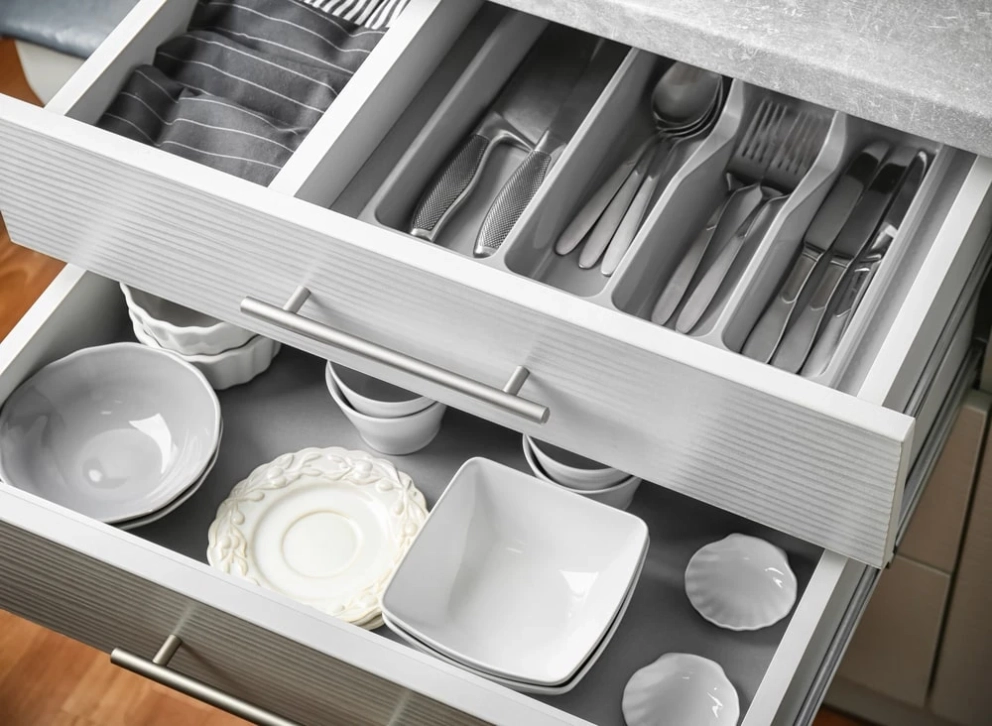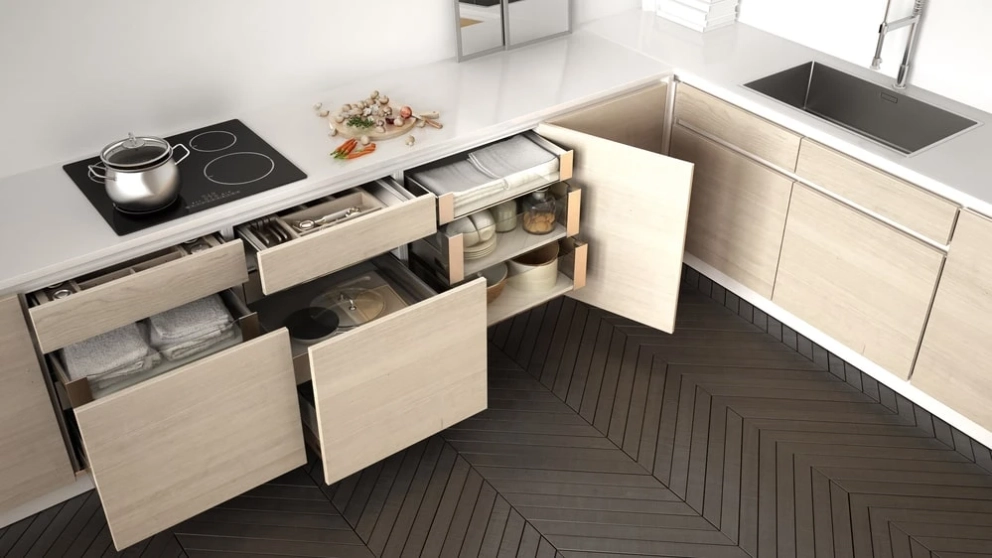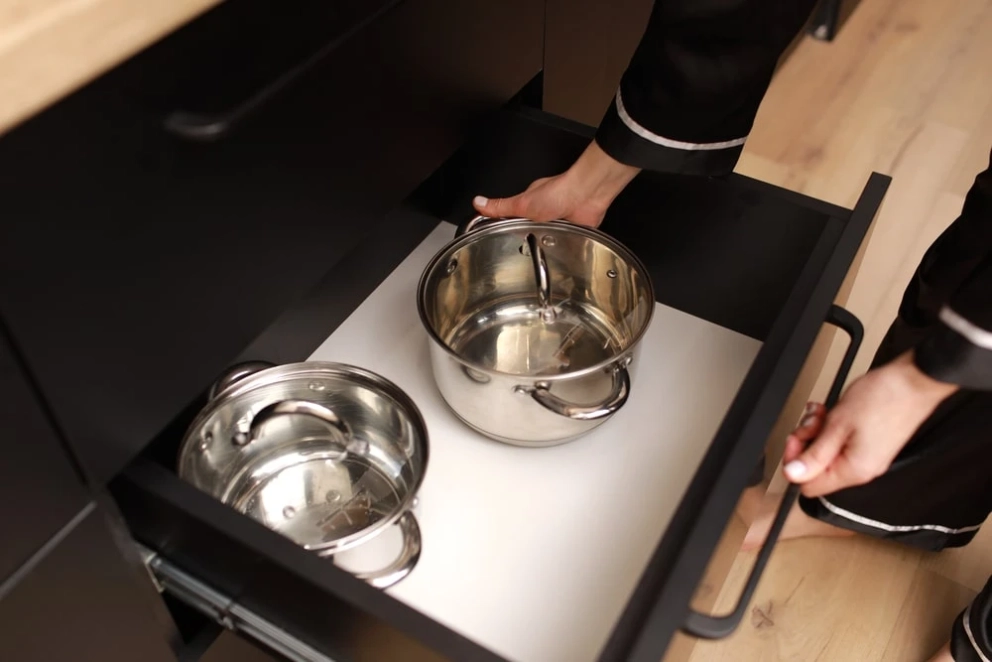Lining cabinets and drawers. Protect your kitchen cabinetry with inside cabinet covers

Do you remember that pleasant feeling when you just had your kitchen cabinets installed and they were new and beautiful? When you pull out a kitchen drawer, it is perfectly painted, smooth and still smells like wood. You’d rather want to keep them in perfect condition for as long as possible and linings in cabinets and drawers can help you with this task.
Kitchen cabinets are subject to wear and tear from both the outside, affected by humidity, cooking grease, and cleaning products, and the inside. We place dishes, utensils, goods, and appliances on the inner shelves. Some of these items may leave stains on the cabinet surface, water may drain from the glass, or crumbs may hang from the toaster. When you open a drawer, its contents may roll around inside and cause scratches, affecting the appearance of kitchen units. This may not only ruin the appearance of your kitchen drawers but can also lead to more serious damage requiring repair.
To avoid mechanical damage, stains and debris, it is essential to line kitchen cabinets while they are brand new. You can use kitchen cabinet liners to add a touch of style and decor. With the right choice of inside cabinet covers, you will get even more beautiful shelves and drawers that are now protected from daily wear. The best way to line kitchen drawers with cork or another soft material that will protect their interior from scratches and dust. Vinyl liners offer a waterproof solution. The options are endless! In this blog, we’ll explore what to line kitchen drawers with and provide guidance on how to measure and cut the lining for optimal results.
Types of kitchen drawer liners

When it comes to line kitchen cabinet drawers, the options are endless. From kitchen cabinet paper to peel-and-stick liners, there are a variety of inside cabinet liner materials to choose from that can protect your kitchen surfaces while adding a touch of style. Let's take a closer look at the different types of kitchen drawer liners and their benefits.
- Kitchen cabinet paper
Kitchen cabinet paper refers to a kind of paper for inside cabinets. It is also commonly known as contact paper for drawers and is a classic choice for lining your kitchen cabinets and drawers. It comes in a variety of colours and patterns, making it easy to match with your kitchen décor. Plus, it's affordable and easy to replace when it gets dirty or worn out.
- Peel and stick drawer liner
Peel and stick shelf liner is a perfect cabinet liner for those who want a no-fuss solution for lining their drawers and shelves. They are self-adhesive and can be easily cut to fit any size drawer or shelf. Plus, they are easy to clean and remove when needed.
- Cork liner for cabinets
Cork liners are a great option for those who want a natural and sustainable material to line their cabinets and drawers. Cork is naturally antimicrobial, making it perfect for use in the kitchen where hygiene is important. Plus, it adds a unique texture and warmth to your kitchen décor.
- Vinyl liner for wire shelves
If you have wire shelves in your kitchen, then a transparent vinyl liner is the perfect solution to prevent items from falling through the wires. It's easy to cut and install, and it can be easily cleaned with a damp cloth.
- Liner for under kitchen sink
The area under the kitchen sink is often a damp and mold-prone space. A kitchen sink cabinet liner specifically designed for under the sink can protect your cabinets from water damage and mould growth. These under-kitchen sink liners come in a variety of materials, such as plastic or rubber, and can be easily cleaned.
Best way to line kitchen cabinets and drawers

Are cabinet liners necessary? This is a question that many homeowners ask themselves when it comes to lining old kitchen cabinets and drawers. The answer is a resounding yes! Not only do liners for kitchen cabinets protect your cabinets and drawers from damage, but they also make them easier to clean and organize.
When it comes to lining old kitchen cabinets, it's important to first clean and prepare the surfaces. Use a mild soap and water to remove any dirt or grime, and allow the surfaces to dry completely before applying the liner. If your cabinets have any rough or uneven spots, consider sanding them down before applying the liner to ensure a smooth and even surface.
Now, onto some creative kitchen cabinet lining ideas! If you want to add a pop of colour or pattern to your cabinets, consider using adhesive liners with fun designs. You can also mix and match different cabinet shelf liner ideas for a unique look. If you prefer a more natural look, consider using cork liners or even fabric liners for a cozy feel.
When it comes to applying cupboard shelf liners, it's important to measure the cabinets and drawers carefully to ensure a perfect fit. Cut the liner to the correct size and then carefully apply it, smoothing out any bubbles or wrinkles as you go.
Putting kitchen cabinet liners is a simple yet effective way to protect them from damage while also making them easier to clean and organize. With so many different types of liners available, including shelf liners for kitchen cabinets, there's no reason not to give it a try. So, go ahead and get creative with your kitchen cabinet liner ideas and transform your space into a stylish and functional oasis!
How to line kitchen drawers

Kitchen drawers can be a catch-all for everything from utensils to junk mail. To keep your drawers organized and protect them from scratches and damage, lining them is a great solution. But how do you line kitchen drawers and what to line cabinets with?
- Measure the inside of the drawer
First, start by measuring the inside of the drawer. This will help you determine how much liner material you'll need. Consider using adhesive liners, and other kitchen drawer liner ideas as they are easy to apply and stay in place. Non-adhesive lining drawers, such as cork or fabric, can also be used, but they may require some additional fastening or adhesive to keep them in place.
- Leave some extra material on the edges
When lining kitchen shelves and drawers, make sure to leave some extra material on the edges so you can fold it over to create a neat and finished look. If your liner is adhesive, peel off the backing and carefully place it inside the drawer.
- Use double-sided tape or adhesive
If you're using a non-adhesive liner, consider using double-sided tape or adhesive strips when lining cupboards and drawers. When lining kitchen drawers measure the inside of the drawer and cut the liner to size. Then, carefully place the line for the kitchen drawers inside, making sure to smooth out any wrinkles or bubbles.
- Use different colors to keep everything organized
If you have multiple drawers to line, consider using different colours or patterns for each one to help with organization. You can also label the drawers to make it easier to find what you're looking for.
Best way to line shelves
Most shelf lining ideas are often seen on kitchen cabinets and drawers. But kitchen shelves cover also exist. There are different kitchen shelf liner ideas that you can do to your open shelves and display shelves. Lining kitchen shelves is pretty much the same as lining cabinets and drawers. The only difference is that when it comes to lining kitchen shelves, you should be more careful and meticulous when applying the liner to ensure that it is integrated smoothly.
Different kinds of materials to use for lining kitchen cupboards

The process of lining cupboards can vary. There are different kinds of materials you can use as cupboard shelf liners. Here are the most common ones.
| Material | Description |
| Cork liner | Cork liners are a sustainable and eco-friendly option, considered the best way to line kitchen cabinets. They are naturally water-resistant and can help absorb moisture, making them perfect for damp areas like under the sink. Cork liners can also add a unique texture and natural look to your kitchen decor. |
| Contact paper | Contact paper is a popular and versatile option for lining cupboard shelves. It is available in a wide range of colors, patterns, and textures, and can easily transform the look of your kitchen cabinets. Contact paper is also durable and easy to clean, making it a great choice for high-use areas. However, it can be difficult to remove and may leave a sticky residue behind. |
| Fabric | Fabric liners are a great option if you want to add some style and texture to your cabinets and drawers. They are available in a range of patterns and materials, such as cotton or linen, and can be easily removed and washed. However, fabric liners are not as durable as other materials and may collect dust between fibres. |
| Vinyl | Vinyl liners are a popular choice for lining cabinets and drawers as they are affordable and easy to clean. They are available in a wide variety of colours and patterns, so you can easily find one that matches your kitchen decor. Vinyl liners can also help protect your cabinets and drawers from scratches and spills. |

